Serving 60 students in grades 7-12, River Bend Area Learning Center ranks in the top 50% of all schools in Minnesota for overall test scores (math proficiency is top 50%, and reading proficiency is top 50%).
The percentage of students achieving proficiency in math is <50% (which is higher than the Minnesota state average of 45%). The percentage of students achieving proficiency in reading/language arts is <50% (which is lower than the Minnesota state average of 51%).
The student:teacher ratio of 12:1 is lower than the Minnesota state level of 13:1.
Minority enrollment is 20% of the student body (majority Hispanic), which is lower than the Minnesota state average of 39% (majority Black and Hispanic).
Quick Stats (2025)
- School Type: Alternative school
- Grades: 7-12
- Enrollment: 60 students
- Student:Teacher Ratio: 12:1
- Minority Enrollment: 20%
- Graduation Rate: 40-49% (Btm 50% in MN)
- Overall Testing Rank: Top 50%
- Math Proficiency: <50% (Top 50%)
- Reading Proficiency: <50% (Top 50%)
- Science Proficiency: <50% (Top 30%)
- Source: National Center for Education Statistics (NCES), MN Dept. of Education
Top Rankings
River Bend Area Learning Center ranks among the top 20% of public schools in Minnesota for:
Category
Attribute
Most improved public schools
School Overview
River Bend Area Learning Center's student population of 60 students has declined by 9% over five school years.
The teacher population of 5 teachers has declined by 54% over five school years.
School Type
Grades Offered
Grades 7-12
Total Students
60 students
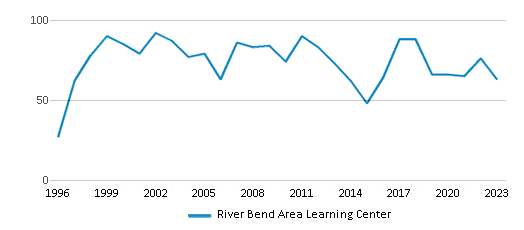
Gender %
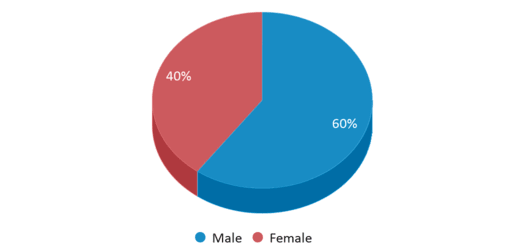
Total Classroom Teachers
5 teachers
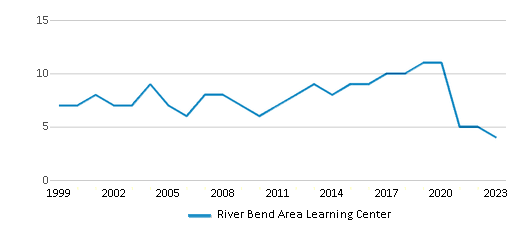
Students by Grade
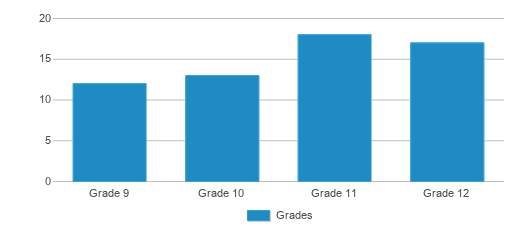
School Rankings
River Bend Area Learning Center ranks within the top 50% of all 1,860 schools in Minnesota (based off of combined math and reading proficiency testing data).
The diversity score of River Bend Area Learning Center is 0.33, which is less than the diversity score at state average of 0.59. The school's diversity has stayed relatively flat over five school years.
Overall Testing Rank
#695 out of 1860 schools
(Top 50%)
(Top 50%)
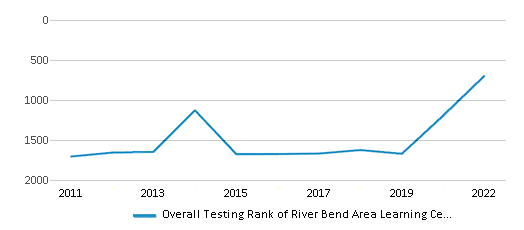
Math Test Scores (% Proficient)
<50%
45%
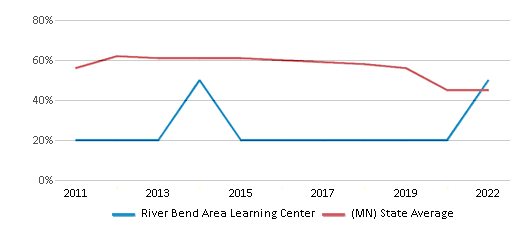
Reading/Language Arts Test Scores (% Proficient)
<50%
51%
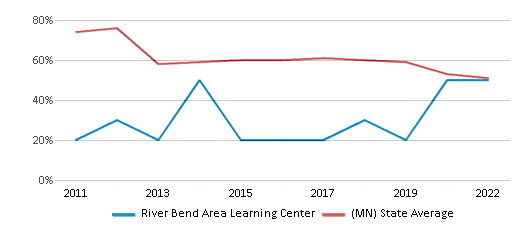
Science Test Scores (% Proficient)
<50%
41%
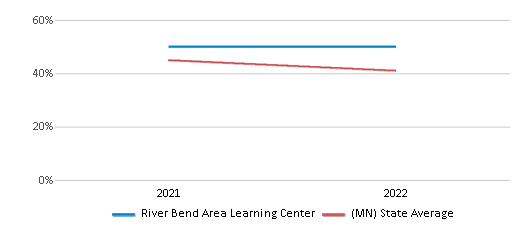
Student : Teacher Ratio
12:1
13:1
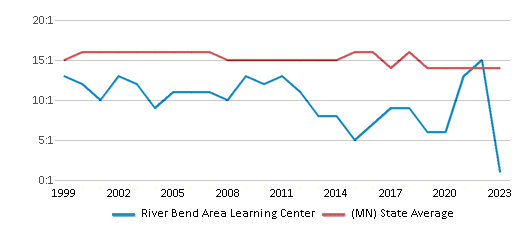
American Indian
n/a
2%
Asian
n/a
7%
Hispanic
18%
12%
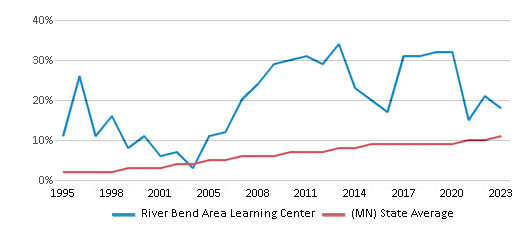
Black
2%
12%
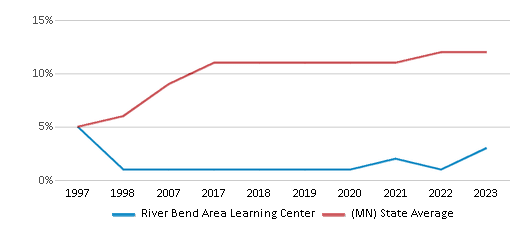
White
80%
61%
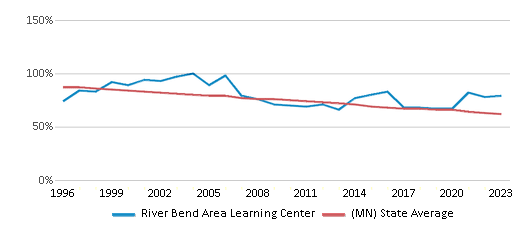
Hawaiian
n/a
n/a
Two or more races
n/a
6%
All Ethnic Groups
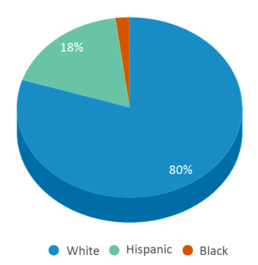
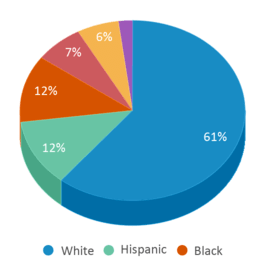
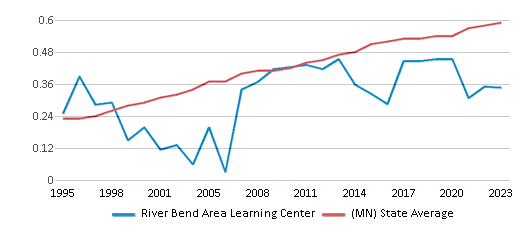
Graduation Rate
40-49%
84%
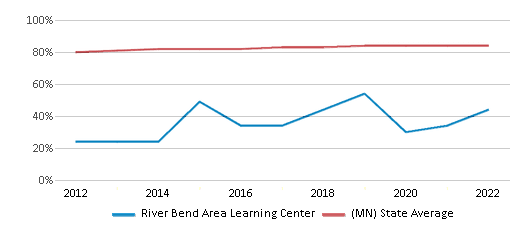
Participates in the National School Lunch Program (NSLP)
Yes
Eligible for Free Lunch
33%
36%
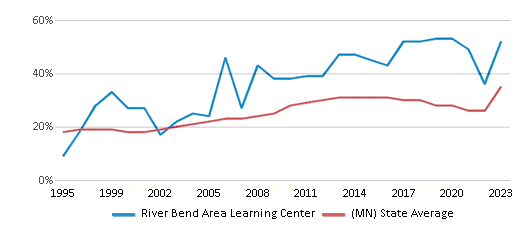
Eligible for Reduced Lunch
17%
7%
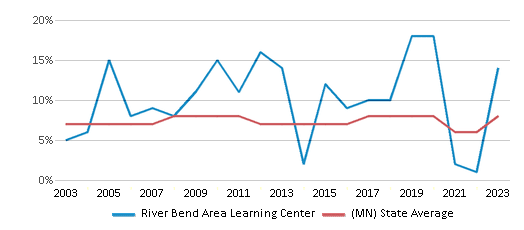
School Statewide Testing
School District Name
Source: National Center for Education Statistics (NCES), MN Dept. of Education
Profile last updated: 02/09/2025
Frequently Asked Questions
What is River Bend Area Learning Center's ranking?
River Bend Area Learning Center is ranked #695 out of 1,860 schools, which ranks it among the top 50% of public schools in Minnesota.
What percent of students have achieved state testing proficiency in math and reading?
<50% of students have achieved math proficiency (compared to the 45% MN state average), while <50% of students have achieved reading proficiency (compared to the 51% MN state average).
What is the graduation rate of River Bend Area Learning Center?
The graduation rate of River Bend Area Learning Center is 40-49%, which is lower than the Minnesota state average of 84%.
How many students attend River Bend Area Learning Center?
60 students attend River Bend Area Learning Center.
What is the racial composition of the student body?
80% of River Bend Area Learning Center students are White, 18% of students are Hispanic, and 2% of students are Black.
What is the student:teacher ratio of River Bend Area Learning Center?
River Bend Area Learning Center has a student ration of 12:1, which is lower than the Minnesota state average of 13:1.
What grades does River Bend Area Learning Center offer ?
River Bend Area Learning Center offers enrollment in grades 7-12
What school district is River Bend Area Learning Center part of?
River Bend Area Learning Center is part of River Bend Education School District.
School Reviews
5 10/14/2017
I have learned the meaning of family and trust and loyalty when I went to this scjool, I've seen kids come in being hood rats and gang bangers and now they are living good and are still conected to the school cause they helped the students realize what's really important in life and they are right by your side 24/7 you can literally talk to any of those teachers and tell them anything, granted they might tell a couple of other teachers if it's huge like u killed someone but they have all literally been through hell and back multiple times and even went through it with the students just to show that there is still pride left to make you bigger and better, which is why the schools mascot is a Phenix, cause no matter what happens u can always be better.
5 10/6/2012
The teachers are incredibly dedicated, and go the extra mile for the students and their families! Academics are excellent!
Review River Bend Area Learning Center. Reviews should be a few sentences in length. Please include any comments on:
- Quality of academic programs, teachers, and facilities
- Availability of music, art, sports and other extracurricular activities
Recent Articles

What Is A Charter School?
Explore the world of charter schools in this comprehensive guide. Learn about their history, how they operate, and the pros and cons of this educational innovation. Discover key facts about charter schools, including admission policies, demographics, and funding, as well as what to look for when considering a charter school for your child.

10 Reasons Why High School Sports Benefit Students
Discover the 10 compelling reasons why high school sports are beneficial for students. This comprehensive article explores how athletics enhance academic performance, foster personal growth, and develop crucial life skills. From improved fitness and time management to leadership development and community representation, learn why participating in high school sports can be a game-changer for students' overall success and well-being.

February 05, 2025
Understanding the U.S. Department of Education: Structure, Impact, and EvolutionWe explore how the Department of Education shapes American education, from its cabinet-level leadership to its impact on millions of students, written for general audiences seeking clarity on this vital institution.






